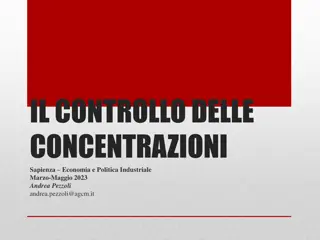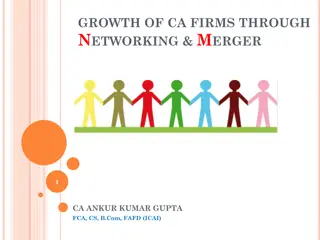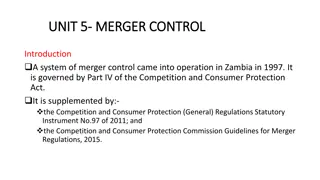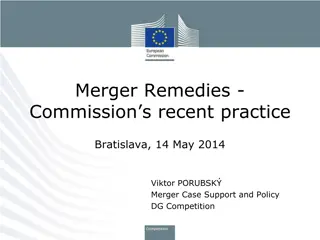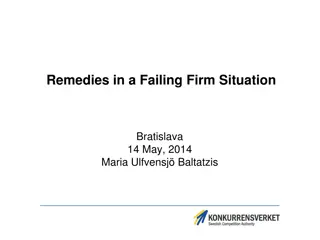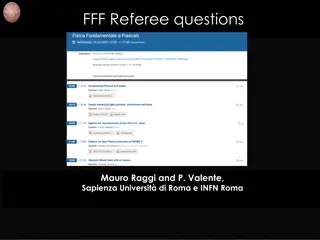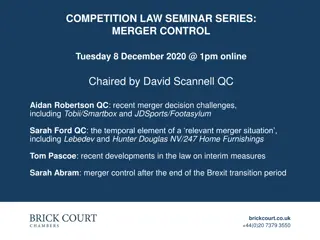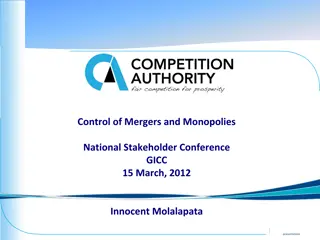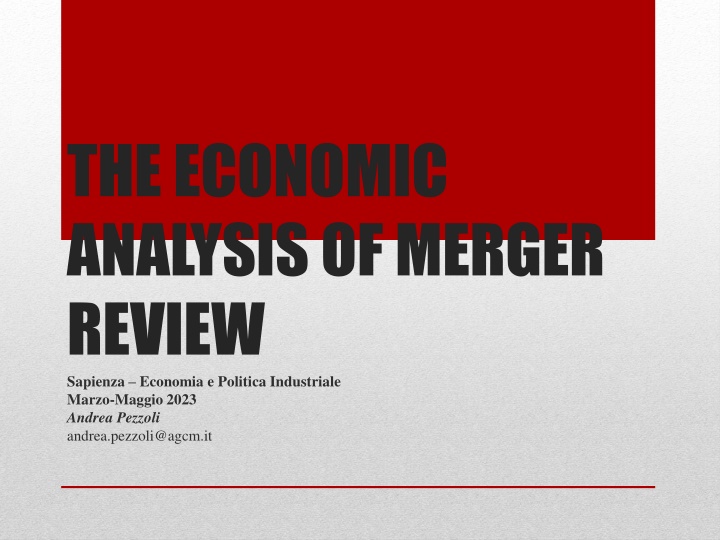
Economic Analysis of Merger Review: Key Concepts and Methods
Explore the economic analysis of merger reviews, covering topics such as dominance, specific effects, efficiencies, and procedural issues. Learn about the role of economic analysis within the merger review process, including data collection and assessment methodologies. Discover common empirical methods used in the analysis of mergers and the importance of descriptive data analysis in evaluating industry and company data.
Download Presentation

Please find below an Image/Link to download the presentation.
The content on the website is provided AS IS for your information and personal use only. It may not be sold, licensed, or shared on other websites without obtaining consent from the author. If you encounter any issues during the download, it is possible that the publisher has removed the file from their server.
You are allowed to download the files provided on this website for personal or commercial use, subject to the condition that they are used lawfully. All files are the property of their respective owners.
The content on the website is provided AS IS for your information and personal use only. It may not be sold, licensed, or shared on other websites without obtaining consent from the author.
E N D
Presentation Transcript
THE ECONOMIC ANALYSIS OF MERGER REVIEW Sapienza Economia e Politica Industriale Marzo-Maggio 2023 Andrea Pezzoli andrea.pezzoli@agcm.it
In the middle-ground between Antitrust and Regulation: Merger Review The test for assessing a merger: from Dominance to SIEC The counterfactual and the specific effects Unilateral effects and price pressure analysis: the role of quantitative analysis Coordination effects Non-horizontal mergers: vertical integration and conglomerate Efficiencies Failing Firm Defense Acquisitions of Potential Competitors and Killer Acquisitions Procedural issues: thresholds, timing, remedies MERGER REVIEW: OUTLINE
Economic analysis is an important tool On a conceptual /theoretical basis and .at a quantitative/empirical level Economic analysis as a complement of qualitative evidence much depends on data availability Collection and assessment of economic evidence has to happen within given procedural framework and time-frame (Phase1 and Phase2) The Role of Economic Analysis in Merger Review
Descriptive data analysis Measures of substitutability Direct estimation of competitive constraints UPP-style analysis Demand estimation and merger simulation For more details, see e.g. DG COMP s submission to the OECD roundtable on economic evidence in merger analysis (Feb. 2011), available online at: http://ec.europa.eu/competition/international/multilateral/2011_feb_economic_evidence.pdf Common Empirical Methods
Descriptive analysis of industry data Retail scanner data (e.g. Pernod/Ricard, Kraft/Cadbury, M. 5658 Unilever/Sara Lee Body Care) Consumer panel data (e.g M. 5658 Unilever/Sara Lee Body Care) Import/export databases (e.g . M. 5907 Votorantim/Fischer) Descriptive analysis of company data Transaction-level data (e.g. M. 5046 Friesland/Campina, M. 4747 IBM/Telelogic) Bidding data (e.g. M. 5421 Panasonic/Sanyo) Descriptive event analysis (e.g. M. 5335 Lufthansa/SN Holding) Descriptivedata analysis
If good data on quantities and prices (and other relevant factors) are available, it may be possible to estimate elasticities (demand system estimation) Examples: M.3796 Omya/Huber, M.5046 Friesland/Campina, M.5114 Pernod Ricard/V&S Approximation: evidence on customer switching Do we have information about some incident where the price of the products of one market participant went up while the prices of other products were held constant. What happened? Can we get a good idea of where the customers went? Survey evidence Examples: M. 4439 Ryanair/Aer Lingus, M.4919 Statoil/ConocoPhillips, M.5335 Lufthansa/SN Holding (Brussels Airlines). => Combined with margin data, this can give an indication of the pricing pressure ( UPP , etc.) created by the merger (data reliability is key for the weight to attribute to such measures). Measures of substitutability (elasticity and diversion ratios)
Dominance Significant Impediment to Effective Competition Substantial Lessening of Competition And what about efficiency? WhichTest?
Market shares and market concentration Diversion Ratios and Proximity The competitive situation (the competitive pressure that the main players exert on one another) Unilateral effects on price (and/or quality) Coordinated effects Barriers to entry Countervailing power Efficiencies (?) The Main Steps of The Competitive Assessment
The starting point is the comparison of the post- merger effects with the competitive conditions prevailing at the time of the concentration (pre- merger scenario or status-quo counterfactual) But We have to assess only the effects which are merger specific Deterioration independently of the merger should not be taken into account of competition taking place CounterfactualScenario
Theoretical (Chicago is crumblingConsumer welfare has been challenged a number of theoretical models Post- Chicago, Behavioural, Hipster..MORE EMPIRICAL WORK) Political (Consensus on Competition is crumbling : Capital is mobile, labour much less lot of people are stuck geografically and professionally the rosy picture every body will be better off is challenged only rich and educated people benesit from competition?...ADVOCACY FOR A BETTER LABOUR MARKET OR ANTITRUST SHOULD TAKE THESE ISSUES INTO ACCOUNT?) MergerSpecificEffects(i.e.counterfactualanalysis)
Cross-section analysis (actual competition): Price-concentration analysis: are there differences in prices in geographic areas where both 1 and 2 are present when compared to areas where only one is present? Example: M.4919 Statoil/ConocoPhillips Time-series analysis (potential competition): Entry event: are there examples of entry of, say, company 1 into geographic areas where company 2 was already present? Did the price of 2 change (significantly)? Example: M.4439 Ryanair/AerLingus Natural experiments are of particular interest: Unexpected plant closure: what impact does it have on prices? How are imports affected? Examples: M.3625 Blackstone/Acetex, M.4734 Ineos/Kerling Competitive Constraints: Econometric Analysis
In bidding markets useful information can be found from tender offers (bidding analysis): Do the merging parties systematically participate in the same tenders (and refrain from participating in the same tenders)? When one of the merging parties wins a contract, does the other often come high (perhaps even second) in the ranking? Cross section analysis (see above): are there differences in the prices offered in those tenders where both 1 and 2 are present when compared to tenders where only one is present? Examples: M.3083 GE/Instrumentarium, M.3216 Oracle/PeopleSoft, M.4647 AEE/Lentjes, M.4662 Syniverse/BSG, M.5232 WPP/TNS, M. 5421 Panasonic/Sanyo, M. 5669 Cisco/Tandberg What if in the past there were no tenders? Are there alternative methods to rank the potential competitors? (Example: Italgas-Acegas- Aps/Isontina Reti Gas) Competitive Markets Constraints: Bidding
In general market shares and other structural indicators (HHI) provide a measure of market power only in very specific circumstances (i.e. Cournot competition with homogeneous products). When products are (perceived) as differentiated, market shares and structural indicators are poor indicators of market power. It is crucial to understand how close are the products Mergers with differentiated products: God is dead, Marx is dead, market definition is dead and I m not feeling too well my self!!
Diversion Ratios UPP (Upward Pricing Pressure) combines two elements which influence price pressure: Positive pricing pressure arising from diverted sales Negative pricing pressure due to cost efficiencies GUPPI (Gross Pricing Pressure Index) does not take into account cost efficiencies and measures the incentives for the acquiring firm to increase prices IPR (Illustrative Price Rise) indicates the price increase due to the merger Price Pressure Analysis: the new tools
Injunction, Prohibition, Clearence Sanction (up to 10% of the sales) Committments Leniency Interim Measures The idea behind the Diversion Ratios
Two shortcomings of UPP Cost efficiencies are generally not known When UPP is >0, price increases may actually be small Two refinements: GUPPI, which measures the incentive for firms (eg A) to increase prices Illustrative price rise (IPR), which indicates the price increase due to the merger. IPR requires a functional form for the demand (linear, isoelastic, ecc ). The results depend also on the degree of symmetry among the merging parties Price Pressure Indicators: UPP, GUPPI and IPR
Use available data to estimate the parameter of the demand model Make some assumptions on the competition model and use that to recover cost parameters Simulate the post-merger equilibrium using the estimated demand and cost functions Possibility to introduce efficiency gains Possibility to allow firms to withdraw products or reposition products Evaluate the effect of the merger on prices but also on consumer surplus Merger Simulations: the key steps
Price pressure screens are easier to implement and require limited information Prices, costs and diversion ratios for the parties products only Useful when the clock is ticking fast (as in our case) Merger simulation is clearly more sophisticated and precise but that takes time! Useful at later stages, but, given the time it may take simply to collect the necessary data, it is often necessary to think about it very early Not always easy, as it could involve collecting data even before knowing whether it will be used or not! Some useful middle ground? Price Pressure Indicators vsMerger Simulation
Benefits in terms of efficiency if: i) Markets are contestable (ex ante); ii) Firms can enjoy the profits from innovation; iii) Sinergies After the merger incentives to innovate may weaken (unless the investment expands the rivals demand ) Consumers lose unless efficiencies can offset the increase in prices and the reduction of investment After the merger the Parties may: stop producing some products, reposition some products introduce new products Impact on Investment and Innovation (Shapiro (2012); Motta&Tarantino(2017); Federico et al. (2018); Julienn&Lefouli(2018) ) (Novartis/GNK Oncology, GE/Alstom and Dow/Chemical/Du Pont)
Definition of Potential Competitors Outside the Product or Geographic Market Acquisition of Innovative Potential Competitors Killer Acquisitions Mergers in Digital (Lear/CMA, 2019) and Pharmaceutical Markets (Cunningham et al. 2021) Acquisition of Potential Competitors
KILLER ACQUISITION: What about the counterfactual? Would the start up become an innovative and efficient player in a stand alone scenario? (i.e. without the merger)
Acquisition of Innovative Potential Competitors Impact on Innovation: the counterfactual The incentives of the incumbent and of the new entrant: the profits of the old innovation, the profits of the new innovation; the duopolistic profits The Upstream market: the R&D market Novartis/GSK Oncology; GE/Alstom; Dow Chemical/DuPont Acquisition of Potential Competitors
Traditionally prohibited (no efficiency mainly becouse they can eliminate the double marginalization) Influence of the Chicago School Modern Economics is more skeptical (Fumagalli et al. 2020) Digital Mergers: mixture of vertical and horizontal effects (Facebook/Giphy, Facebook/WhatsApp) vertical incentives mergers to are not pro- exclude, Vertical Mergers
Traditionally no problematic mergers but three possible theories of harm: Bundling and obstacle to interoperability Competitive advantage in terms of data, custumers base or other assets that cannot be matched by other (as efficent rivals ) The acquisition of a company that today sells a complementary good might competitor 1. 2. 3. eliminate a potential ConglomeralMergers
The closure of the target firm is the most relevant scenario FFD criteria: 1. Failing firm (division of a group or firm?) 2. Assets of the FF would "inevitably leave the market" in the absence of the transaction 3. "market would deteriorate to at least the same extent in the absence of the Merger" ( 89 HMG): analysis of merger against closure scenario 4. no less anti-competitive alternative to the merger. Failing Firm Defence
Focusing on most likely counterfactual is a simplification Often, this simplification is justified For example if other scenarios are relatively unlikely or don't lead to materially different effects What if likelihood assessment is imprecise and/or the effect across counterfactuals differ vastly? prohibiting (in the absence of efficiencies) if the alternative buyer scenario would have been more likely than closure? bankruptcy almost same effect as merger, but on-going competition much better for consumers Failing Firm Defence
A merger may enhance competition by bringing together complementary assets, thus leading to lower costs and/or higher quality Possible pro-competitive effects may offset the loss of competition between the merging parties (balancing exercise) Under existing merger practice, focus is on consumer welfare Efficiencies
Direct/static claims Example: Marginal cost reductions from elimination of double marginalisation Indirect/dynamic claims Example: Fixed costs reductions by avoiding duplication of infrastructure Quality improvements Example: use of scarce asset (spectrum) across larger customer or asset base Need to take care to avoid double-counting Efficiencies: a simple taxonomy
Strike a balance between accepting valid claims and rejecting claims where benefits to consumers are too uncertain Static efficiencies easier to verify and hence more likely to be accepted In recent cases efficiencies more often submitted, assessed and also accepted For more details see: Buehler & Federico, "Recent Developments in the Assessment of Efficiencies of EU Mergers", 2016, Competition Law & Policy Debate, 2(1), p. 50-61 Efficiencies: concluding remarks
Introduction and Overview (Sections I and II). Market share and concentration levels (Section III). Section describing possible anti-competitive effects of horizontal mergers (Section IV). Sections describing factors that could mitigate the initial finding on competitive effect (V. Countervailing buyer power, VI. Entry, VII. Efficiencies, VIII. Failing firm defence). Horizontal Merger Guidelines
Introduction and Overview: Purpose: Guidance in the assessment of horizontal mergers. Ultimate objective: protect consumers by ensuring effective competition. Comparison of situation absent the merger with the conditions that would have prevailed with the merger (counterfactual). Horizontal Merger Guidelines
Market share and concentration levels: First useful indications of market structure. Measure: %-share and HHI. Below 25% combined market share unlikely to harm competition. Post-merger HHI: below 1000; between 1000 and 2000 (delta below 250); above 2000 (delta below 150) unlikely to harm competition unless . Horizontal Merger Guidelines
Anti-competitive effects: Non-coordinated and coordinated effects. Important factors for non-coordinated effects: Large market shares and increment. Merging firms are close competitors. Customers have limited alternatives. Competitors are constrained by capacity or merged entity. Elimination of an important competitve force. Merger with a potential competitor. Mergers leading to buyer power in upstream markets. Horizontal Merger Guidelines
Countervailing factors: Countervailing buyer power. Entry. Efficiencies. Failing Firm. Horizontal Merger Guidelines
The parties Kraft Foods Europe is a multinational (and multiproduct firms) and owner of the Simmenthal brand (the leading brand for canned meat in Italy) Bolton is the most important producer of branded canned food and owner of the best known brands (Manzotin, Rio Mare, Alco, Palmera) The merger adds yet another brand (Simmenthal) to Bolton s portofolio Manzotin/Simmenthal: Merge to monopoly?
In this particular case, market shares (70-80%) were considered sufficient to go to Phase II High market shares do not necessarily mean that the merging parties may be able to increase prices (post merger); this may be especially the case if products are differentiated Analysis aimed at understanding to what extent one of the merging parties constrained the other s pricing (and viceversa), i.e. are they close competitors? How close ? The aim of quantitative analysis
Price pressure screens are easier to implement and require limited information Prices, costs and diversion ratios for the parties products only Useful when the clock is ticking fast (as in our case) Merger simulation is clearly more sophisticated and precise but that takes time! Useful at later stages, but, given the time it may take simply to collect the necessary data, it is often necessary to think about it very early Not always easy, as it could involve collecting data even before knowing whether it will be used or not! Some useful middle ground? Price Pressure Indicators vsMerger Simulation
Merger conditionally approved, making binding the commitments proposed by the parties up-front buyer solution, i.e. commitment to suspend the implementation and the closing of the proposed merger Process near completion AS do MAR, which is a very successful player in the canned food sector, bought the brand THE DECISION
The merger Manzotin/Simmenthal was quite clearcut. Most of the problems which generally arise with the use of the so called new tools could easily be solved: We could save the new tools for Phase II: market shares were so high not to require anything else to screen the merger The restrictive patterns critique could be easily avoided: just few and differentiated brands we had not to deal with the design of the nests or dimensionality issues The merging parties were evidently close competitors: diversion ratios were self evident and well above standard thresholds Which lesson from the Manzotin/Simmenthalcase?
We had no choice in selecting the demand form: asymmetric IPR formulas only available for linear demand IPR s were quite high (6-9% at the market level, 14-21% for Manzotin!!): quantitative results were neither grey nor conflicting with qualitative data Even the remedy seems to be proportionate, appropriate and we hope effective!! Which lesson from the Manzotin/Simmenthalcase?
New tools strike a good balance in the assessment of mergers with differentiated products. In these cases the relevant market approach may be misleading (but don t forget that New tools require the same ingredients used for proper market definition ) New tools are best used as a complement to traditional analysis (market shares, brand loyalty, relative weakness of private labels, countervailing power ) Lower thresholds can be used in Phase I to screen mergers that should go to Phase II (higher probability of type-II error, but that can be further assessed - and dealt with - in Phase II, as in Bolton Group International/Luis Calvo Sanz, merger ) the canned tuna Which lesson from the Manzotin/Simmenthalcase?
Use of UPP, GUPPI, Diversion Ratios Just to screen mergers or can be used to measure unilateral effects? Time matters Not immediate how to deal with the so-called grey area arising from different functional forms and thresholds (see next slide) What thresholds? And demand form? In our case (the asymmetric case), IPR formulas only available for linear demands (lower bounds) What is the appropriate threshold when efficiencies are incorporated? How should be dealt with conflicting evidence (i.e. high concentration and IPRs)? OPEN ISSUES

